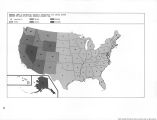| OCR Text |
Show officials in determining the amount of forage necessary to sustain game and the level of game harvest required to control the amount of game to be supported. Because dependent base property and public grazing lands are so closely linked, removal of all requirements for obtaining and holding grazing permits would be undesirable. However, the system of keeping deficit records for unused grazing privileges is also undesirable. The retention of existing eligibility requirements for the allocation of privileges up to the recent levels of forage use would not impair the rights of current users. Guidelines would be established to specify the obligations to present users. One way of doing this would be to set each present permittee's obligated use at the average level of actual use during the last 5-year period. Forage that became available beyond this level would be subject to allocation to new applicants. Increases in forage production beyond the level of present actual use should be allocated through the operation of the market. This would add flexibility to the system of allocation, would benefit the general public as public landowners and consumers, and would encourage efficiency of operation by ranchers using public land grazing. The principal requirement we propose would be operation of a bona fide ranch in the area in which the public lands are located. It is not proposed to bar presently qualified users from participating in allocation of the increased forage. Since competition for grazing privileges, at least in some areas, would be limited, a minimum price should be established to protect the public interest. Tenure Recommendation 40: Private grazing on public land should be pursuant to a permit that is issued for a fixed statutory term and spells out in detail the conditions and obligations of both the Federal Government and the permittee, including provisions for compensation for termination prior to the end of the term. Under present law, grazing privileges are generally awarded under term permits or leases of specified duration. Grazing district permits issued under the Taylor Grazing Act may not exceed 10 years. A 10-year maximum primary term also has been established administratively for permits issued by the Forest Service and the National Park Service. Department of Defense agencies issue permits for 5 years, and the Bureau of Reclamation may issue 50-year permits, but does not do so in practice.6 In the case of permits within grazing districts under the Taylor Grazing Act, permittees have a statutory preference right of renewal over other applicants for grazing permits, although the granting of the renewal itself is discretionary.7 Forest Service permits are granted administratively in a manner essentially the same as under the Taylor Grazing Act. In practice, grazing use of public lands is quite stable because permits are generally renewed unless there is another Federal use for the land, or the permit terms have been violated. Downward adjustments in permitted use because of range conditions are provided for in most agency permits and, when range becomes badly deteriorated, the practice is to make such adjustments rather than to refuse to renew permits. Additionally, allocation of the available forage to another use, such as wildlife, may be made. Permits may also be terminated for failure to comply with the terms of the permit. Most disturbing to permittees, however, is the fact that permits may be cancelled at any time if the land covered passes from the administrative control of the particular agency issuing the permit, as by withdrawal or exchange. Permittees are not usually entitled to compensation for reduction of use or permit termination. There are limited exceptions to this. When the land is directed to use for defense projects, the loss of the permit may be compensated.8 Also, when a permit is terminated, in some instances the permittee may be compensated for loss of improvements he has placed on the land.9 We recommend that the term of grazing permits should be established by statute. A fixed statutory permit term would give administering agencies some guidance as to planning land uses and providing for changes in use. Agencies would have to plan land use adjustments around times at which permits are terminated, rather than make decisions on a largely ad hoc basis. Permittees would have a greater assurance of use during the life of the permit and thus make more efficient use and improvement plans for the permitted lands. Assurance of tenure for a fixed period of time would also increase the permit value as security for operational and improvement loans. We recommend also that grazing permits should detail with greater precision the range conditions which will trigger use changes {both increases and decreases). If the permit term is to be fixed by statute, then there must be assurance that the land will be properly used during the life of the permit. 6 University of Idaho, The Forage Resource, Ch. II. M3U.S.C. § 315b (1964). S43U.S.C. §315q (1964). "43C.F.R. §4115.2-5(a)(7)(i). 109 |







































































































































































































































































































































































